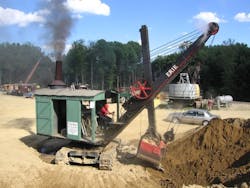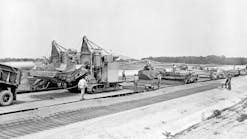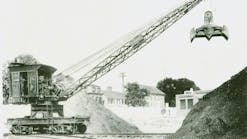The Ball Engine Company was founded in Erie, Pa., in 1883 to manufacture stationary industrial steam engines. Recognizing that the market for such engines was maturing, it began manufacturing steam shovels in 1914. This diversification took place following a conversation between a Ball vice president and A.C. Vicary, a salesman for Thew Shovel. Vicary had some forward-thinking ideas about improving the design, manufacture and marketing of steam shovels, and Ball hired him and applied his ideas.
Ball used the name of its hometown as the trade name for its line of steam shovels, as did Thew with its Lorain machines. Ball initially produced only two models, the 1/2-yard model A and the 3/4-yard B. The thinking behind this was to minimize costs by simplifying and streamlining manufacturing and service through the use of standardized, mass-produced parts that were interchangeable between the two models.
Oddly, the Erie B’s introduction predated that of the A by about a year. The A and B could both be mounted on crawlers or steel traction wheels, and the B was also available with railroad wheels. The B could be set up as a steam shovel with various combinations of booms and dipper sticks for general, overburden, railroad ditching, or open-trench excavation. The steam shovels could also be outfitted as a crane or dragline, although it had limitations as a dragline due to the low line pull typical of steam excavators.
The Erie A and B steam shovels were aggressively promoted, and their design concepts proved so successful that Ball dominated the small-excavator market. Ball Engine spun off its stationary steam engine lines in 1920 and became Erie Steam Shovel in 1922. The Erie B was replaced in 1925 by the B-2 Dreadnaught, a 7/8-yard excavator that was intended to be a transitional machine into the internal combustion excavators that were rendering steam obsolete.
Similar to steam shovels, Bucyrus of South Milwaukee, Wis., had also achieved considerable success with steam excavators, but had only a small share of the market for small machines such as the Erie A and B. To rectify this, Bucyrus merged with Erie to form Bucyrus-Erie in 1927, following Erie’s reorganization the year before under a new board that included two members of the Bucyrus board of directors.
All production of B-E small excavators was consolidated into the Erie plant, which remained open until 1984, when it was closed and sold as part of B-E’s restructuring into a manufacturer solely of surface mining machinery consequent to the recession of the early 1980s. Bucyrus-Erie was renamed Bucyrus International in 1996; in 2011, Bucyrus was acquired by Caterpillar and became Caterpillar Global Mining.
The Erie B was a well-designed and solidly constructed machine, factors that have contributed mightily to several of them being preserved today. Two restored and operating Erie Bs, a shovel and a crane, will be demonstrated at the HCEA’s International Convention and Old Equipment Exposition at the I.U.O.E. Local 150’s ASIP center near Wilmington, Ill., August 16-18.
The Historical Construction Equipment Association (HCEA) is a 501(c)3 nonprofit organization dedicated to preserving the history of the construction, dredging and surface mining equipment industries. With more than 4,000 members in 25 countries, activities include operation of National Construction Equipment Museum and archives in Bowling Green, Ohio; publication of a quarterly magazine, Equipment Echoes, from which this text is adapted, and hosting an annual working exhibition of restored construction equipment. Individual memberships are $30 within the U.S. and Canada, and $40 elsewhere. Information is available at www.hcea.net, 419.352.5616, or [email protected].





